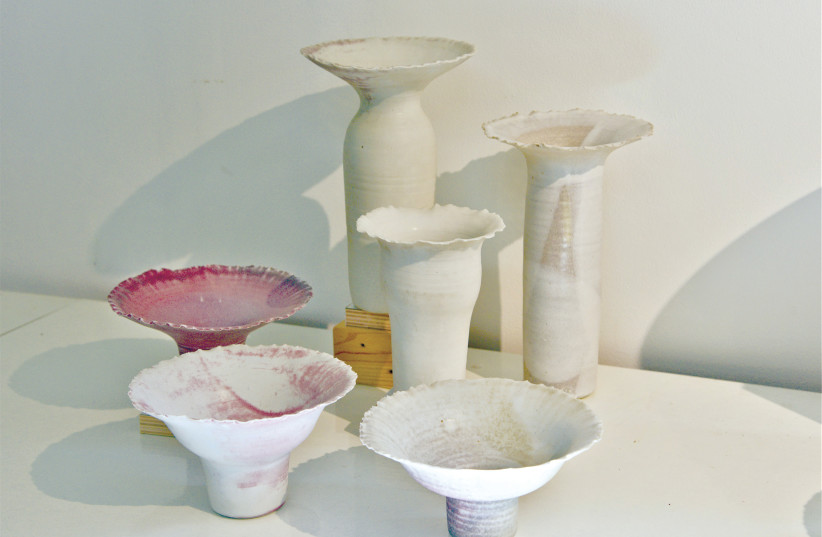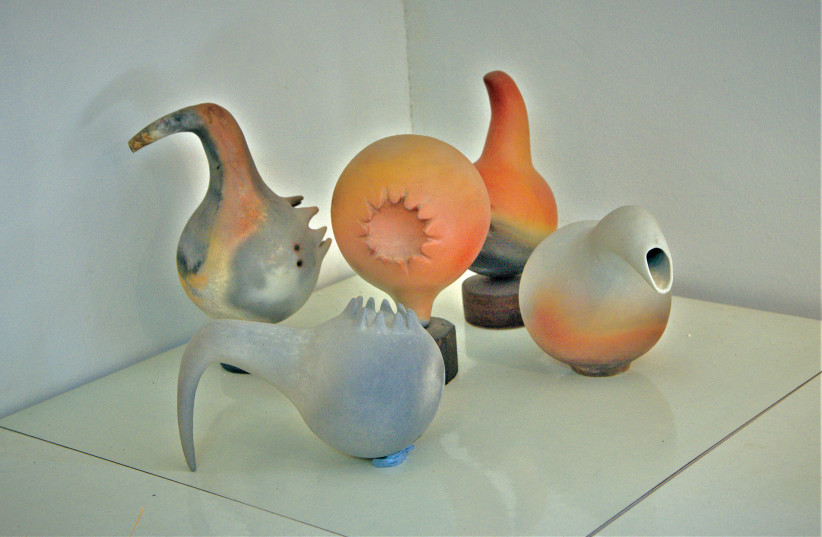One of the first impressions gained from looking at the clay, stoneware and porcelain works of the late Jean Mayer (1924-2000) is their perfect simplicity. Unlike, say, Keat’s Grecian Urn with its highly decorated motifs, Mayer’s jars, bowls, vases, vessels, pots, bottles, wall-reliefs and sculptures are characterized by their clean shapes and exquisite forms.
Absent is any ornamentation that would divert attention from the basic material being used, materials such as clay and stoneware. Their surfaces reflect the smooth, colored glazes that had been applied to them, finishing them not only as usable products but also, and perhaps essentially, as works of art. That said, she was also involved in the ongoing discussion among fellow professionals on whether ceramics and pottery were art or a craft.
Her works were produced in her studio, located in Kibbutz Ein Hashofet in the middle of the country. The Mayers were attracted to the kibbutz first because they were both socialist-leaning, and second because it was the first kibbutz settled by a group of Americans and named after an American Jewish judge, Louis Brandeis.
The kibbutz was the first and only home that she and her husband, Alex, knew since making aliyah from England in 1951.
According to her son, Yaron, who now lives on the kibbutz with his wife and son, “she enjoyed the kibbutz since it was very culturally alive.”

In England, Mayer originally studied theater design but switched to painting and pottery. She attended two well-known art schools, at Chelsea and Camberwell.
In pottery particularly, it was a time of radical changes in England. Initiated by Bernard Leach and Shijo Hamada from Japan, they introduced clean lines in their designs and used natural, monochrome colors for their works, as opposed to more decorative motifs that characterized Victorian era pottery.
At Camberwell School of Art, Mayer studied under Richard Kendell, who was Bernard Leach’s son-in-law. To these must be added the work of two Jewish refugees from Europe, Lucie Rie and Hans Cooper, who Mayer knew personally, and who were a major influence on Mayer’s later work.
Mayer’s husband, Alex, was Hungarian-born but because of restrictions against Jews, his parents sent him to London in 1938. When the war started in 1939, he joined the army and became a soldier and a British citizen. His family was religious Zionist in Budapest, but when he came to Israel with his wife he became secular.
During the war, his parents managed to come to Israel and settle in Haifa. His sister Judith, who is 93, is a ceramic artist herself. She lives in Beersheba where she recently sold her studio in the old city.
Jean’s parents were Zionists. Her father had a jewelry shop, and was very supportive of Zionism. Her father was originally Romanian and collected money to bring over Jews from Romania and Poland to Israel. She herself visited Israel as a young girl. Returning to England she studied art.
But when she met Alex they decided to go to Israel together to find out what they could do on kibbutz – she as an artist, and Alex, who had studied economics and who also wanted to be a useful, practical member of the kibbutz. It was then that she thought about ceramics. So a few months before emigrating she studied ceramics in London.

On kibbutz, Mayer had to fit into the rough, tough life of the settlement. Although she had brought a kiln and potter’s wheel with her from England, she had to wait two years before she was able to set it up, albeit in a tent! In 1954 she began to teach painting, art history and ceramics at Harei Efraim high school, a position she held for 15 years.
In the 1960s she transferred her small studio to what was once a chicken shack, where she was joined by an American sculptor and ceramicist, David Morris, who had heard of her and was interested in working together. The two worked in co-operation for 40 years, even though their styles were very different.
In the mid-’60s she designed a fish-shaped sculpture to be used in the children’s swimming pool, one of the many public works Mayer produced for the kibbutz and beyond. The fish still adorns the kibbutz swimming pool.
She branched out into wall-reliefs and environmental structures, notably the totems for the Kibbutz Central Office in Tel Aviv. She was even commissioned to design bedroom lamp bases for the Hilton Hotel. On the kibbutz itself, members really appreciated her work and many of them still have sets of her work in use.
Her reputation spread. When Batsheva de Rothschild opened a shop in Tel Aviv to sell Israeli art, she saw some of Mayer’s works, came to the kibbutz, and bought a number of pieces that she displayed in her shop.
One young couple, Betty and David Eppel, were given 300 lira as a present from her father to go on a honeymoon. They were planning to celebrate in Eilat when they went to a shop in Tel Aviv and saw “a wonderful set of dishes” designed by Mayer that was selling for more than 300 lira. They took their honeymoon money and bought it. “I still use them and treasure them,” says Betty Eppel, who lives in Jerusalem.
This was typical of Mayer’s early work. She was doing mainly useful products – pots, teapots, plates, and so on. Later she turned to sculpture, using different materials. She started to work with porcelain and not just clay.
Among other things, she was asked by the Bezalel Art School to be a judge of the student’s work. She also had an exhibit there. Here and there she taught foreign artists. There were quite a lot of articles on her work in the newspapers and in magazines.
Ever keen on teaching, she was asked to set up a ceramics faculty in the Art Department of the University of Haifa, which enabled students to combine their theoretical studies with practical work.
In 1971 she became only the second artist to join the UNESCO-sponsored International Academy of Ceramicists. Back on the kibbutz she acquired a gas kiln that allowed her to work at higher temperatures. She experimented with a number of different clays, one of which was named “Jean” after her discovery of it. During this time her work was exhibited in many solo and group shows in Israel and abroad.
In 1975, she began teaching adults at the Megiddo Regional Hall, a role she continued for 20 years.
In 1985 she returned to the University of Haifa for two years, with some of her students working as her assistants in her kibbutz studio. Among the works she created were small sculptures of animals, including a charming one of her own pet dog, “Muff.” These animal sculptures sold well.
With her passing, the kibbutz, which owned her works, gave the family a part of their mother’s studio as a permanent gallery, giving the rest to two other artists.
Yaron, one of Mayer’s three children who works for the Ministry of Foreign Affairs and returned with his wife and son to live on the kibbutz, is keen to turn his mother’s studio/gallery into a place where other potters can come, work and learn from her innovations.
“In 2015, I was in Nepal with the family when there was an earthquake and a lot of her works that were with us were broken,” Yaron says. “The earthquake lasted 42 seconds. We were on the second floor. We rushed down but we saw that some of the pieces were broken. We managed to rescue some of the pieces and stuck some of them together.
“In 1999, she decided to have a retrospective exhibition. But she passed away about a month before the opening. The exhibit took place in the museum in Kibbutz Hazorea, and was accompanied by a comprehensive catalog.”
A devoted son, Yaron Mayer – who was recently appointed Israel’s ambassador to Vietnam – observes: “My mother worked with precision. I think she would have liked what we have done with her studio, and the website.”
Jean Mayer’s studio on Kibbutz Ein Hashofet, which displays some unique pieces of her works, is open for visitors to enjoy and appreciate.
For more details, go to the website, https://jeanmayer.co.il/en/home/ ■
